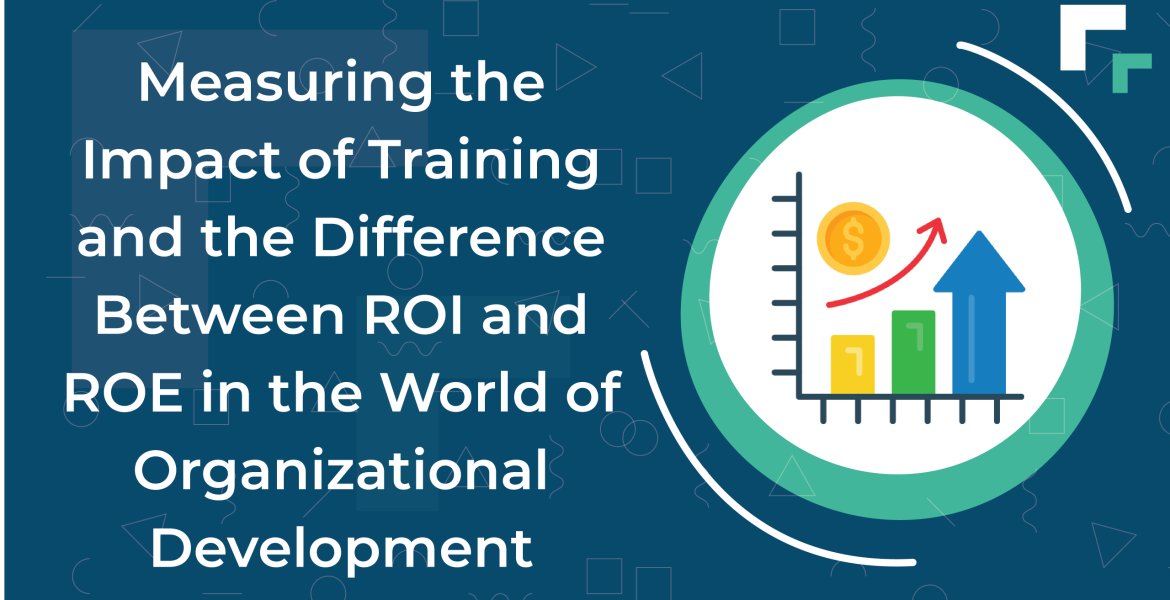Measuring the Impact of Training and the Difference Between ROI and ROE in the World of Organizational Development

Measuring the Impact of Training and the Difference Between ROI and ROE in the World of Organizational Development
Introduction
In modern organizations, training is no longer just an optional activity to enhance skills, it has become a strategic investment measured by its returns and its impact on overall performance. As spending on training and development increases, a central question arises: How can we measure the impact of training? And do the results justify the costs?
Here, two key concepts in organizational development emerge: Return on Investment (ROI) and Return on Expectations (ROE).
Let’s explore how organizations can measure the real impact of training and understand the fundamental differences between these two concepts.
1. Why Do We Need to Measure the Impact of Training?
Measuring the impact of training is essential to ensure that the efforts and resources invested actually deliver the intended value.
Organizations today don’t just execute training programs they look for tangible results that contribute to both individual and organizational performance, such as:
- Increased productivity
- Improved performance quality
- Higher job satisfaction
- Reduced employee turnover
Measuring impact also enables management to make more informed decisions about future programs and identify areas needing further development. Without measurement, training becomes mere spending without clear direction or measurable outcomes.
2. Methodologies for Measuring Training Impact
Organizations can use several methodologies to measure training impact. One of the most famous is the Kirkpatrick Model, which includes four levels:
- Reaction: Measures trainees’ satisfaction with the training experience.
- Learning: Evaluates how much knowledge or skill the trainee gained.
- Behavior: Assesses how much of the new learning is applied in the workplace.
- Results: Measures the actual impact on organizational performance, such as profits or productivity.
In addition to Kirkpatrick’s model, more advanced, data-driven tools can be used, such as Pre & Post Training Analysis and ROI (Return on Investment) Analysis.
3. What Is ROI – Return on Investment in Training?
ROI (Return on Investment) is a financial metric used to determine whether training has produced returns that match or exceed the costs invested. In other words, it measures the profitability of training investments.
General formula:
ROI = (Training Benefits – Training Costs) ÷ Training Costs × 100
Example:
If a company spends $50,000 on a training program and achieves an additional $75,000 in productivity gains, then:
ROI = (75,000 – 50,000) ÷ 50,000 × 100 = 50%
This means the training ROI is 50%, a positive indicator of program effectiveness.
However, while ROI is valuable, it doesn’t always reflect the full value of training especially when it comes to non-financial impacts like improved morale or a healthier work culture. That’s where ROE comes in.
4. What Is ROE – Return on Expectations?
ROE (Return on Expectations) is a qualitative measure that evaluates how well the training meets the goals and expectations set by stakeholders.
Unlike ROI, which focuses on numbers and financial returns, ROE looks at the intangible and behavioral outcomes of training within the organization.
Example:
If the goal of a training program is to improve leadership skills among managers, the impact cannot be measured solely through profit figures. Instead, indicators such as:
- Better employee manager interactions
- Reduced internal conflicts
- Higher team satisfaction with leadership styles
These qualitative outcomes reflect whether the training met the organization’s and employees’ expectations; this is the essence of ROE.
5. The Key Difference Between ROI and ROE
| Comparison | ROI – Return on Investment | ROE – Return on Expectations |
| Main Focus | Financial return from training | Achievement of goals and expectations |
| Type of Measure | Quantitative | Qualitative |
| Results | Numbers and financial ratios | Behavioral and performance indicators |
| Primary Stakeholder | Financial management | HR and stakeholders |
| Ultimate Goal | Ensuring spending efficiency | Ensuring achievement of desired outcomes |
Modern organizations often combine both ROI and ROE to gain a comprehensive view using ROI to assess financial value and ROE to capture the true human and behavioral impact.
6. Balancing ROI and ROE
Achieving balance between ROI and ROE requires a holistic approach to training management. Instead of focusing solely on numbers or perceptions, organizations should integrate both financial and qualitative value through:
- Defining clear objectives before training: Identify whether the goal is financial or behavioral.
- Designing results-oriented programs: Link training content to organizational goals.
- Using balanced performance indicators (KPIs): Combine productivity, satisfaction, career development, and innovation.
- Continuous evaluation: Follow-up after training is as important as delivery itself.
This balance allows organizations to maximize the value of their investment in human capital.
7. Challenges in Measuring Training Impact
Despite the availability of models and formulas, organizations face several challenges in measuring training impact, such as:
- Difficulty isolating influencing factors performance can be affected by market or management changes.
- Lack of accurate data some organizations don’t track pre- and post-training metrics.
- Internal resistance employees may reject the idea of linking performance to training results.
- Difficulty measuring behavioral aspects such as leadership, creativity, or emotional intelligence.
To overcome these challenges, organizations can adopt modern analytical tools such as Business Intelligence (BI) and Predictive Analytics, which provide accurate, data-based insights on performance and impact.
8. Embedding a Measurement Culture in the Workplace
Measuring impact shouldn’t be a one-time post-training activity it should be a core organizational culture. When the mindset of “every training must have measurable outcomes” is embraced, organizations start designing more focused and effective programs.
A measurement-driven culture also promotes transparency and accountability, ensuring that training serves real, measurable goals not just activity for its own sake.
9. Conclusion
In the world of organizational development, measuring training impact is no longer a management luxury, it’s a strategic necessity.
ROI provides a clear financial view of training efficiency, while ROE helps understand the human and behavioral outcomes that are equally vital.
When organizations learn to balance both, they measure not only “how much they earned” but also “how much they evolved.”
Frequently Asked Questions (FAQs)
- What is the difference between ROI and ROE in training?
ROI measures financial return, while ROE evaluates the qualitative and behavioral achievement of training expectations. - Can training impact be measured accurately?
Yes if clear objectives, accurate pre- and post-training data, and an effective follow-up system are in place. - Why is measuring impact important for small organizations?
Even small businesses need to measure impact to ensure efficient use of resources and continuous performance improvement. - Can a training program be successful even with a low ROI?
Yes if it achieves critical qualitative goals such as improved employee satisfaction or leadership effectiveness. - What’s the best way to integrate ROI and ROE in evaluation?
By designing performance indicators that combine financial and behavioral aspects, aligned with the organization’s strategic goals.





